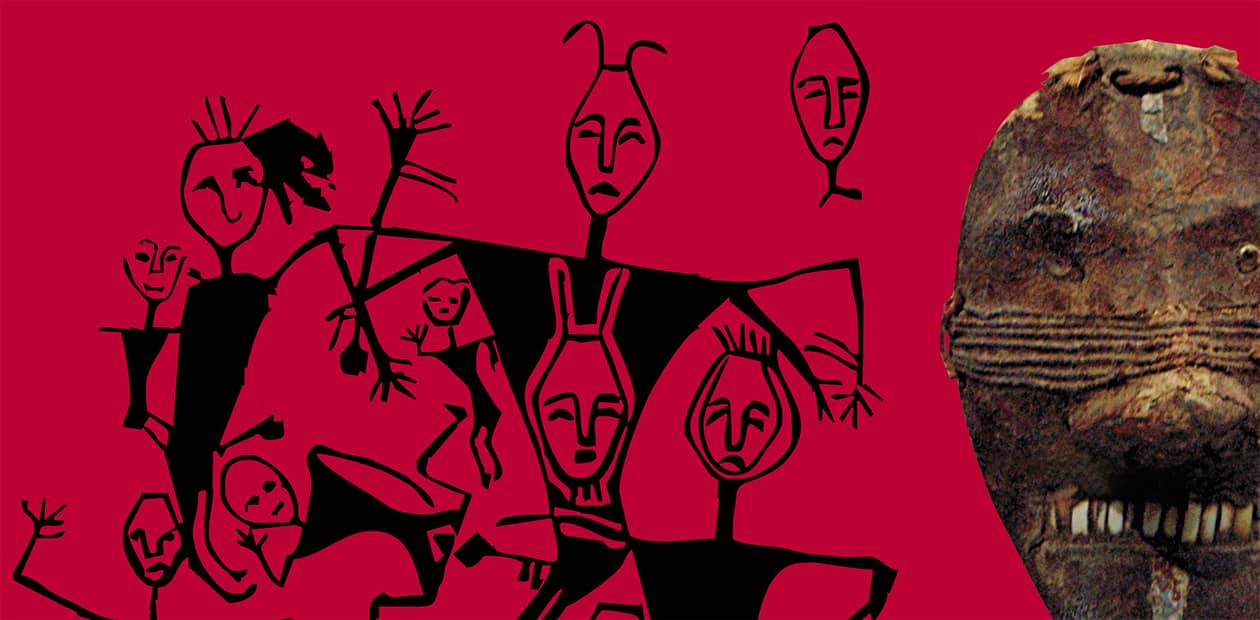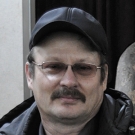Erotica without Eroticism
Over the past three decades, the Kangjiashimenzi rock art site, located in Hutubi County, Xinjiang, about 150 km west of the city of Urumqi, has attracted the attention of both tourists and researchers. A rocky canopy shelters a vertical surface with a unique tableau displaying images of more than a hundred characters. Many online publications, unrelated to science, classify these images as a collection of ancient porn or examples of primitive eroticism
He [Eros] empties us of estrangement
But fills us with kinship,
Causing us to come together
In all such gatherings as these,
In festivals, in dances,
in sacrifices a leader…
Plato. The Symposium (trans. by R.E. Allen)
The visual field of the Kangjiashimenzi tableau presents at its center a scene composed mainly of anthropomorphic figures depicted in a single iconography with a few details that may either be common in all the figures or may be present in individual characters only (a tail in some male figures, ears, various hairdos and headgears, possibly feather decorations, etc.).
All the anthropomorphs are explicitly naked. The phallus is accentuated in men; the hips are highlighted in women. Some characters, which Chinese researchers define as hermaphrodites, exhibit a combination of both traits. However, the style of the images cannot be called realistic. Although this work of rock art obviously depicts easily recognizable acts of a sexual nature, a lot of details clearly indicate events of a fantasy world associated with the life of myth.
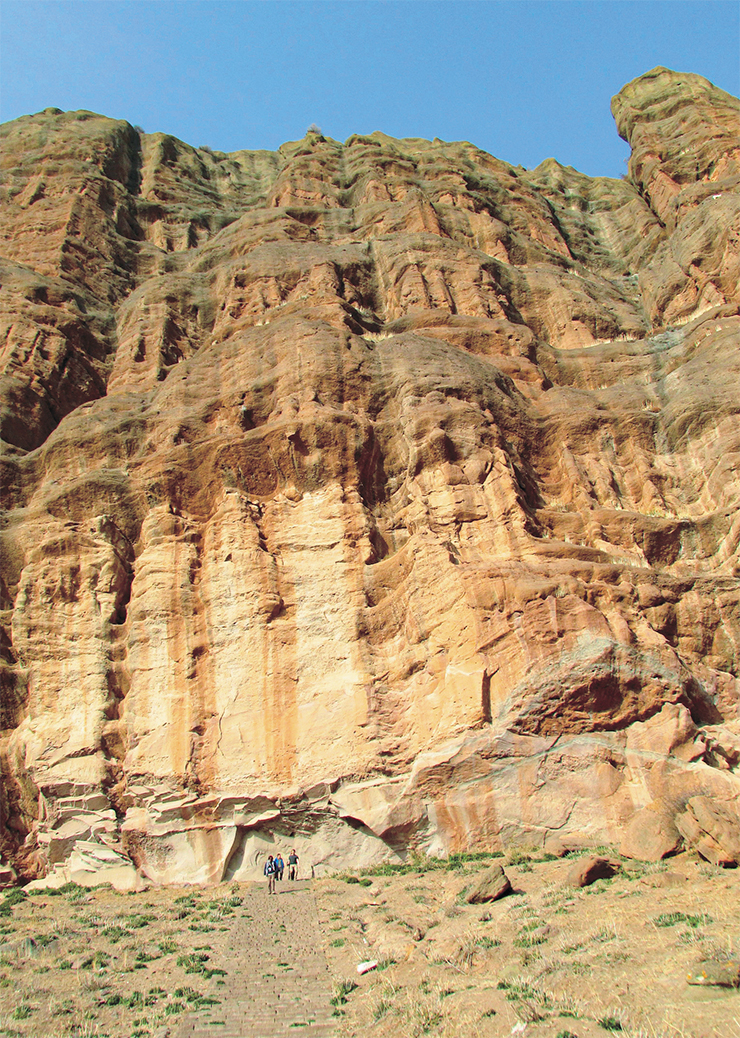
Next to ordinary human bodies, we see the so-called mask images, i. e., face-forward images of human heads, separate from the body, with facial details identical to the physiognomy of complete figures. We also see “incomplete” anthropomorphic images without a head, arms, or legs, as well as fantastic figures with two or three heads, or with mask images on their chests (Komissarov, Cheremisin, and Solovyev, 2020). The petroglyphs of this ensemble exhibit many other fascinating features, the main one being the large number of scenes of a frankly sexual nature, commonly referred to in archaeological science as erotic scenes.
Of course, both anthropomorphs with indications of hermaphroditism and coital scenes show up repeatedly in petroglyphs from different regions – researchers of primitive art have even identified several recurring plots involving two or more characters. However, no other petroglyphs display such a dense concentration of sexual plots as in Kangjiashimenzi, where they form the core of the entire ensemble.
“Earliest transsexual orgy porn”
Our Chinese colleagues, who date the rock art site to a wide chronological range from the Neolithic to the Early Iron Age, also propose a broad variety of interpretations. They attribute the petroglyphs to creative work of different peoples (Sakas, Yuezhi, etc.) and associate their semantics with patriarchal society, fertility cult, shamanism, phallic cults, etc. In our opinion, not all of their interpretations are reliable, but they differ radically from online publications, swarming the Internet, with photographs and drawings of fragments of the Tian Shan scene, which are accompanied by dashing comments on “sexual perversions” in antiquity.
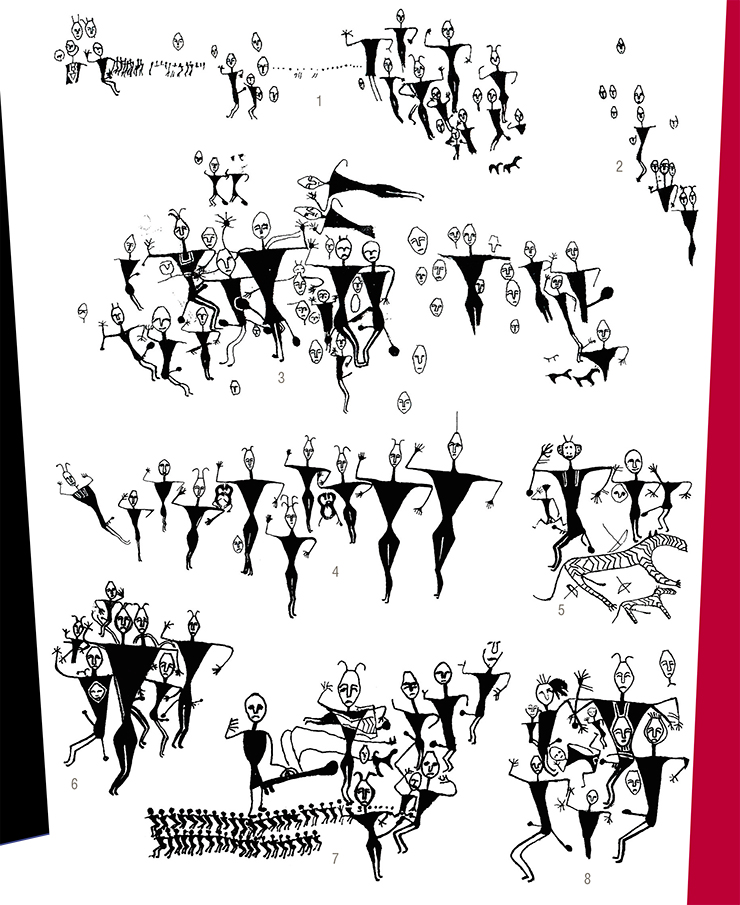
The place for the rock art panel – at the foot of a mountain to protect from cold winds, frequent in this area, under a rocky canopy to shelter from rain and snow – was obviously chosen with care. Close by, only thirty meters away, a spring gushes up – a perfect venue for tribal ceremonies. The sanctuary was used over a long period of time as evidenced by a two-meter layer of ash found on the flat ground in front of the monument (Wang Binghua, 2010)
Thus, a reporter for a reputable British online news portal IBTimes wrote that “cave art in China shows earliest transsexual orgy porn,” referring to the “fresh light” thrown by a certain Mary Mycio, who discovered in the Kangjiashimenzi petroglyphs homosexual activity and group sex with a transgender, and an act of masturbation (Gover, 2013).
Since no qualified archaeologist would ever say such nonsense, we decided to find out the details of the life path of Mrs. Mycio. It turned out that she was born in the Soviet Union but was taken by her parents to the United States as early as in her infancy. After receiving a doctorate in law from New York University, she came to Kiev as a political columnist for the Los Angeles Times, and in 2005 she published a book, of course, about Chernobyl. She currently works as a freelancer, advertising herself as “an international development professional with a broad profile.” Quite expectedly, all this has nothing to do with archeology.
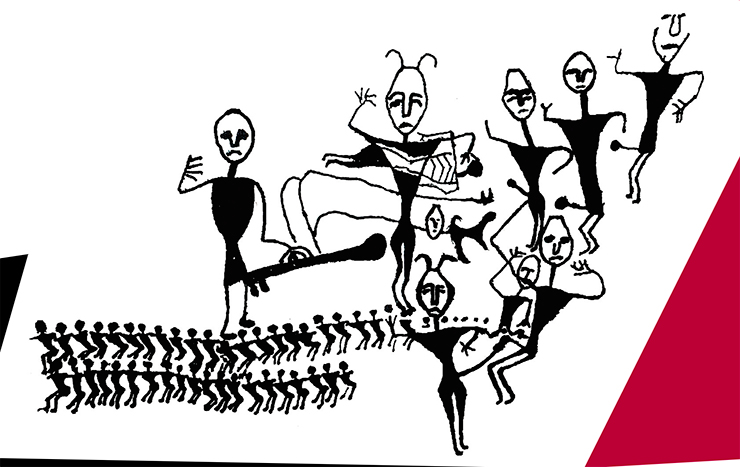
We have a hard time understanding why the editors of the influential online magazine Slate gave Mrs. Mycio the job to write an article about Kangjiashimenzi. Perhaps, they aimed to publish a sensation albeit a scandalous one. And the gamble paid off. Published under a catchy title “Archaeology isn’t for prudes,” the article mentions “sex-crazed ancients” who were “screwing their brains out” in search of fun and fertility (Mycio, 2013).
Well, since none of our Western colleagues stood up for the defamed “ancients,” we shall attempt to advocate for them, but first we should discuss the terminology.
Eros the Firstborn
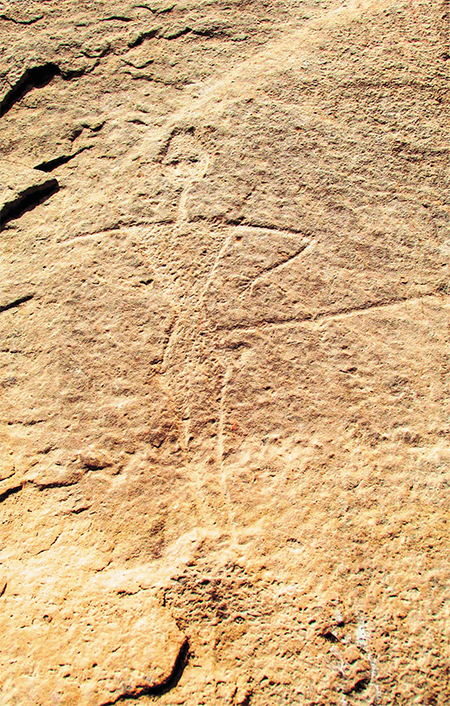 It would be absurd to deny that the Kangjiashimenzi images are most closely connected with those expressions of sexuality in the culture of ancient societies, which manifest themselves at the conceptual level in the notion of erotica in the most initial sense of this term.
It would be absurd to deny that the Kangjiashimenzi images are most closely connected with those expressions of sexuality in the culture of ancient societies, which manifest themselves at the conceptual level in the notion of erotica in the most initial sense of this term.
If we recall Greek mythology, e. g., Hesiod’s Theogony, we remember that Eros, accompanied by Chaos and Gaia, was one of the three demiurge gods. In this triad, according to Aristotle, Chaos represented space; Gaia represented pramatter; and Eros represented the driving force (Lebedev, 2008). In the cosmogony of Orphic hymns, i. e., orations to gods in poetic form, Eros also appears as Protogon (Firstborn), a bisexual creature symbolizing the inseparable union of the feminine and masculine principles.
Therefore, the appearance of figures of bisexual androgynes in the petroglyphs can be considered quite natural, and it serves as additional evidence of the archaism of the depicted plots. At a relatively late stage, this austere cosmological line gave rise to a separate branch of eroticism, a cultural phenomenon that appeals to excessive sensuality and increased sexual excitability so as to exploit this excitability.
The sacred inevitably turns into the profane, but in this case, it is hard to say when this transition happened. This process went differently in different regions, but judging by the data available, the profanation occurred much later than the Bronze Age. Therefore, it is thoughtless to call this ancient pictures pornography, one of the extreme manifestations of eroticism. An absolutely right opinion was voiced by a Chinese journalist who once wrote that the ancient sexual rituals presented in the petroglyphs were completely opposite in their meaning to the Western sexual revolution of the 1960s‑1970s (Qin Ren, 2002). The ancients had more important things to do than satisfy the lust of impressionable descendants – they had to build and maintain world order.
One of the archetypes of mythogenesis, which served as the source and content of primitive art, is associated with the mythologem of birth. It is this mythologem is actualized in the Kangjiashimenzi scene that consists of two groups of schematic human figures standing in a row one after another. Sometimes this row begins with a series of rounded dots, which then transform into a line of tiny humans, in whom the dots become the heads.
Especially interesting is the scene in which two phallic characters are having intercourse with a female character, and a row of dots extends directly from the female figure, followed by two rows of small human figures. Another part of the tableau shows a group with a separate row of dots going from a headless antropomorph to a mask image (the lost head?) and also a line of tiny humans walking towards a single seated phallic figure (perhaps, a local version of those seeking comfort “into Abraham’s bosom” (The Gospel of Luke, ch. 16, verse 22).
When interpreting ancient monuments of figurative art, we often fail to understand the specific content of a scene that embodies an ancient mythologem. It is especially difficult to reconstruct the meaning of individual human and animal figures since they may act as symbols while the semantics of the whole image was dictated by the lost context. But in the case of Kangjiashimenzi, with focus on the conceptual unity of the image ensemble, united by a common idea, and on the manifested plots, which are all part of a unified visual and semantic field of the ensemble, we hope to obtain reliable reconstructions.
“Erotica” of the Bronze Age
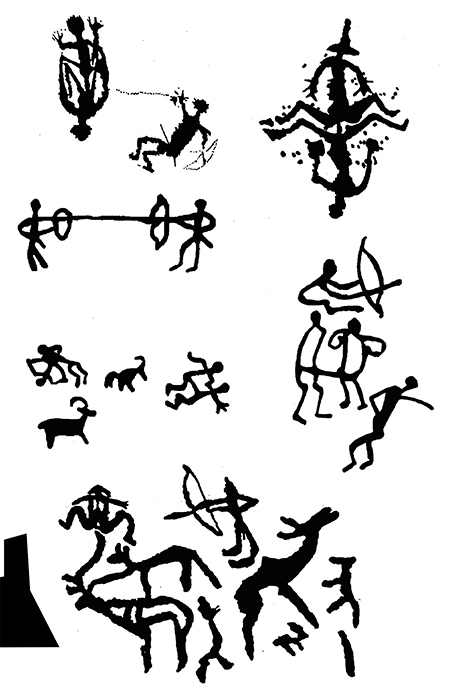
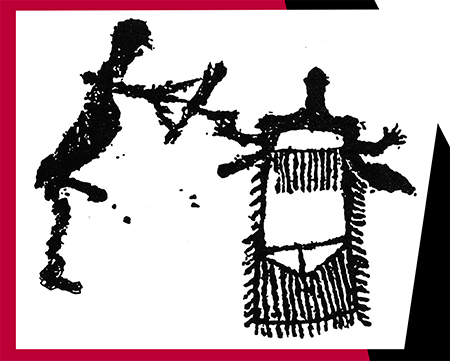 First of all, we should discuss the dating of the Kangjiashimenzi petroglyph ensemble. It is known that anthropomorphic plots, primarily, mask images were a dominant motif in the rock art of Eurasia in the Bronze Age.
First of all, we should discuss the dating of the Kangjiashimenzi petroglyph ensemble. It is known that anthropomorphic plots, primarily, mask images were a dominant motif in the rock art of Eurasia in the Bronze Age.
We get a lot of food for thought if we consider another unique monument located in Xinjiang, i. e., the Xiaohe burial ground in the Lop Nor region, where archaeologists have found quiet numerous wooden face masks with pronounced Europoid race features and an accentuated nose (Molodin, 2019). We see the same features in the rock carvings from Hutubi. The possibility of such an interpretation comes from the fact that judging by the photographs, the tips of the noses in the rock carvings appear to have been lost, which would have been very likely if the noses had protruded substantially forward like those of the masks from the Xiaohe burials. To this we may add the suggestive similarity between the masks in the tombs and the mask images in the petroglyphs.
In addition, according to Prof. Liu Xuetang (2015), the sharply angular heads of anthropomorphs with one or two short lines extending sidewise like little “horns” depict conical felt hats with a rounded top rather than the high pointed caps of the Sakas. The former headdresses, usually decorated with feathers, were “in vogue” among those buried at Xiaohe. Based on this evidence, the researcher attributes both monuments to the same cultural flow and time period. At present, the Xiaohe culture is quite convincingly attributed to the developed Bronze Age and dated to the 17th‑15th centuries BCE. Therefore, it is proposed to attribute the Kangjiashimenzi monument to the same period. It is possible that this rock art site was created by the Tocharians, a mysterious ancient Indo-European nation that would surmount the Tian Shan from north to south.
A thought-provoking analogy was proposed by Prof. Lin Meicun (2003), who pointed out the images of a pair of male and female “shamans” painted on the vessels of the Tianshan Beilu culture in Eastern Xinjiang. He believes that the main figurative techniques (triangular bodies and open-five hands) are fully consistent with the Kangjiashimenzi tradition; therefore, the dating of the culture to which the painted vessels are attributed (approximately the 18th century BCE) could also apply to the petroglyphs.
We should note separately the scenes depicting attacks by a “tiger” (or some other predator) on anthropomorphic characters, including those in a state of coitus. Judging by a different carving technique (deep engraving) and by analogies found on Scythian-time objects, the tigers were engraved on the rock surface later than the main scene yet consciously fitted into its composition to create a single plot.
A number of similar scenes at other rock art sites do not show an act of intercourse itself; however, the sexual nature of the scenes is displayed explicitly, and their semantic similarity, or even identity, is obvious. At least two scenes – from petroglyphs at Bichigtyn Khad in the Gobi Altai (Mongolia) and Eshki Olmes in the Dzungarian Alatau (Kazakhstan) – embody one and the same plot that unites two motifs: sexual activity and a predator attack on people. Based on their style, the scenes could be dated to a period from the beginning to the first half of the 1st millennium BCE, and their origins could be traced to figurative art monuments dated to the middle of the 2nd millennium BCE (for the east of Eurasia, these are petroglyphs and paintings on slabs at burial grounds of the Okunevo and Karakol cultures).
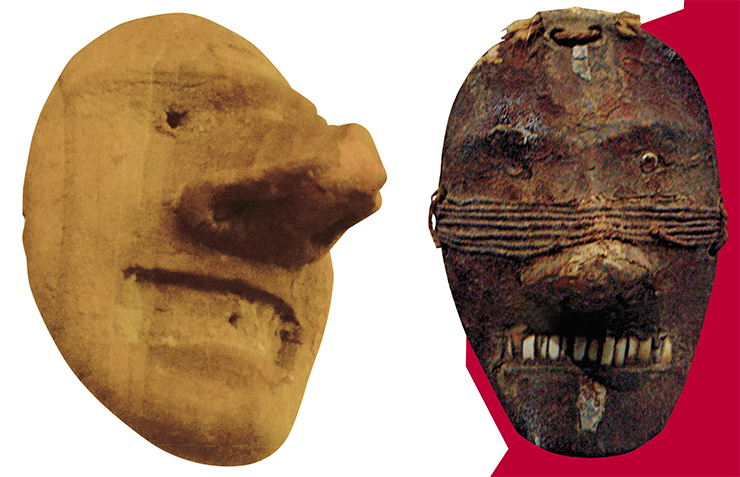
When it comes to interpreting other images in the Kangjiashimenzi tableau, it might be possible to decipher them by identifying a number of semantic units (by this we mean breaking down the single visual field “shot-by-shot”):
• Male characters with a hypertrophied phallus as a manifestation of the productive potential of the individual and the “ancestral body.”
• “Incomplete” human figures, including the aforementioned mask images (heads or face masks), decapitated corpora, and other, possibly dismembered bodies (the confrontation between Eros and Thanatos).
• Characters “incorporated” into each other and multiheaded characters as a demonstration of the connection between the previously separated, or dismembered objects.
• Rows of dots extending from the scene of intercourse and turning into rows of tiny human figures as a model of the generation of a lineage from conception to death and a reflection of the connection between ancestors and descendants.
Special mention should be given to the iconographic similarity (except for details) of all the anthropomorphic images as a clear indication of the kinship of the characters. Most of the anthropomorphs are depicted in motion, as if performing a dance as an essential element of the ritual.
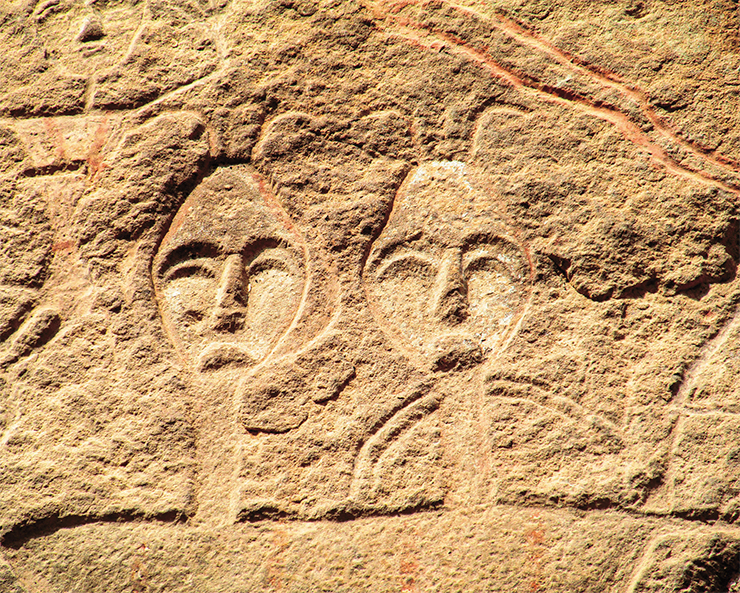
According to Prof. Liu Xuetang (2016), the persistently repeated “disco-dancer” posture (the right arm bent at the elbow and raised up; the left one lowered down) imitates the swastika. This sacred sign was particularly widespread throughout Eurasia since the Neolithic, acting as a symbol of, primarily female, fertility.
Based on a large body of ethnographic and folklore material, we can ascertain the narrative unity of the most part of the giant tableau, which is essentially a detailed representation of ancient mystical ceremonies associated with ancestral or tribal cults and sacred rituals of marriage. It is fundamentally possible to decipher the semantics of the Kangjiashimenzi petroglyph ensemble in the context of mythology associated with Eurasian population of the Paleometallic Era. In fact, this artwork provides a visual replica of ideas about the natal, initiatory, and posthumous transformations of man; about the model of existence of a clan or tribe within natural cosmic cycles; about the transformations of both the individual organism and the “ancestral body” of society.
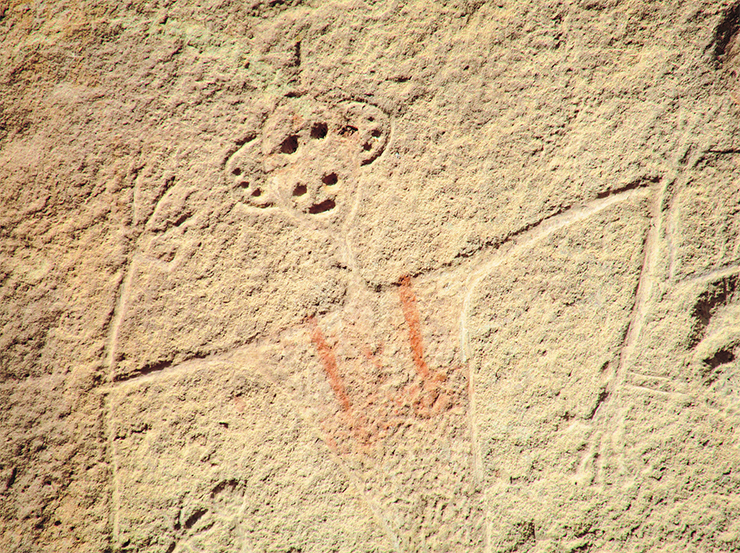
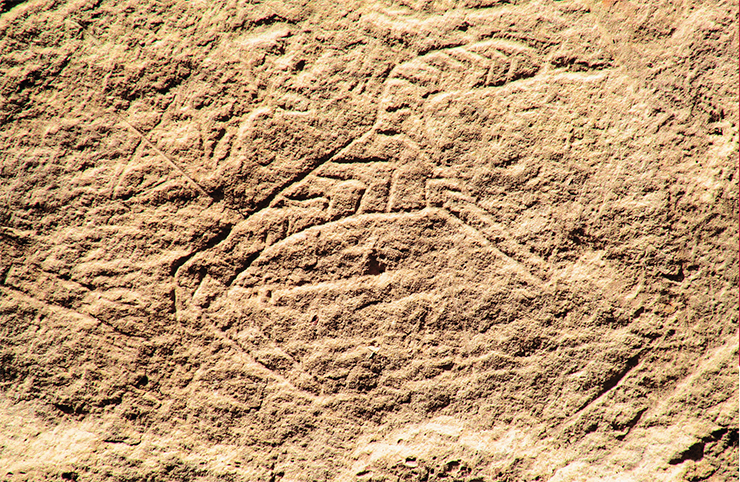
We should also note the close iconographic similarity of the anthropomorphs. We interpret their unity as a manifestation of kinship among all the participants in the ceremony, not necessarily their physical kinship but at least their social community. The life of archaic societies centered around vital acts related primarily to their livelihood, and as the eminent ethnologist Bronislaw Malinowski wrote, “since all these command public interest of joint co-operative groups, every religious ceremony must be public and carried out by groups” (1948, p. 47). “The community whole-heartedly engaged in performing the forms of the ritual creates the atmosphere of homogeneous belief,” and “the evil, disintegrating forces of destiny are thus distributed by a system of mutual insurance in spiritual misfortune and stress” (Ibid., p. 48).
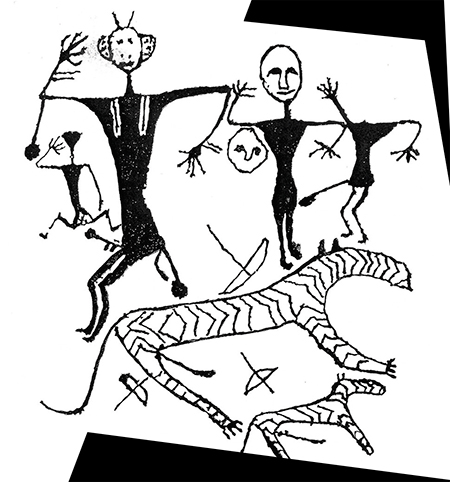 The accumulated ethnographic materials suggest that “the physiological phases of human life, and, above all, its crises, such as conception, pregnancy, birth, puberty, marriage, and death, form the nuclei of numerous rites and beliefs. Thus beliefs about conception, such as that in reincarnation, spirit-entry, magical impregnation, exist in one form or another in almost every tribe, and they are often associated with rites and observances” (Ibid., p. 20).
The accumulated ethnographic materials suggest that “the physiological phases of human life, and, above all, its crises, such as conception, pregnancy, birth, puberty, marriage, and death, form the nuclei of numerous rites and beliefs. Thus beliefs about conception, such as that in reincarnation, spirit-entry, magical impregnation, exist in one form or another in almost every tribe, and they are often associated with rites and observances” (Ibid., p. 20).
The most important times in the life of man in archaic and traditional societies were marked by the so-called rites of passage (rites de passage), as identified by the French anthropologist Arnold van Gennep. These rites had many aspects to them, the most important one supposedly was “the systematic instruction of the youth in sacred myth and tradition, the gradual unveiling of tribal mysteries and the exhibition of sacred objects,” which served as “an extremely efficient means of transmitting tribal lore, of insuring continuity in tradition and of maintaining tribal cohesion” (Ibid., pp. 21, 22–23).
In this regard, the Kangjiashimenzi tableau, as well as other similar ensembles, served both as an illustration of the basic mythologies and as a stage setting of some kind for the performance of rites. Accordingly, the scenes depicted in the petroglyphs bear as remote a relationship to eroticism as they do to art in the modern sense of the term. Ancient forms of artistic creativity in no way served the purposes of sensual or aesthetic pleasure; they were instead a means of interaction with otherworldly forces; an important instrument of socialization; and a method of intergenerational transfer of social norms conditioned by experience, tradition, and myth; a tool to communicate intra-clan or tribal solidarity.
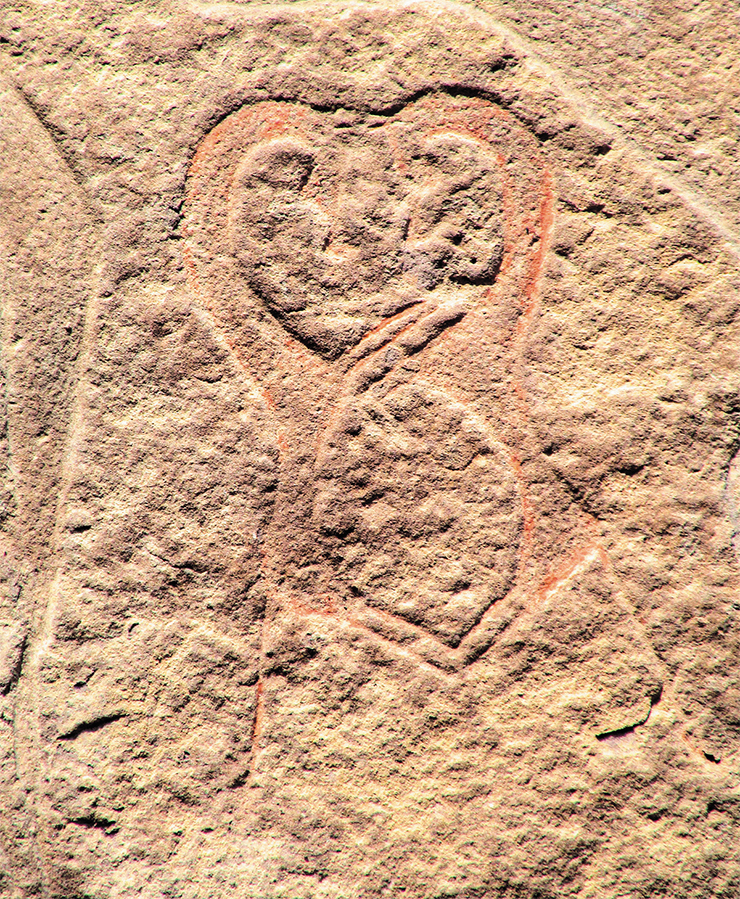
It is likely that the Kangjiashimenzi ensemble captures the culminating points of a specific rite that represents cosmo- or ethnogonic (i. e., related to the origins of a particular people) plots of archaic mythology. It can be assumed that the rock carvings show tribesmen performing an orgiastic marriage ritual that embodies the cultic genealogical myth. It is possible that by participating in mystical ceremonies staged in this “setting,” younger generations would tap into the sacred knowledge. And the rock art site itself should be regarded as a sanctuary of, at least, regional significance.
References
Gover D. Cave art in China shows earliest transsexual orgy porn, claim archaeologists: Kangjiashimenji petroglyphs found in remote Xinjiang region depict frantic sexual imagery // IBTimesUK (news portal), 20.02.2013. URL: https://www.ibtimes.co.uk/cave-art-china-bisexual-porn-kangjiashimenji-petroglyphs-437440
Komissarov S. A., Cheremisin D. V., and Solovyev A. I. Petroglyphs of Kangjiashimenzi (Xinjiang, PRC): once again about the chronology and semantics of the site // Vestnik NSU. Series: History and Philology. 2020. V. 19, N 10: Vostokovedenie. P. 9–22 [in Russian].
Lebedev A. V. Eros // Antichnaya filosofiya: Entsiklopedicheskii slovar’ (Philosophy of Classical Antiquity: An Encyclopedic Dictionary). Moscow: Progress-Traditsiya, 2008. P. 826–827 [in Russian].
Malinowski B. Magic, Science and Religion, and Other Essays. Glencoe, IL:TheFree Press, 1948. 327 p.
Molodin V. I. Wooden masks of the Xiaohe culture // Problemy istorii, filologii, kul’tury. 2019. N 2. P. 7–19 [in Russian].
Mycio M. Archaeology isn’t for prudes: Some of the oldest porn in the world is at least 3,000 years old, and bi-curious // Slate. 14.02.2013. URL: https://slate.com/technology/2013/02/prehistoric-pornography-chinese-carvings-show-explicit-copulation.html
All the photos at the Kangjiashimenzi monument were taken in 2013; the images courtesy of D. V. Cheremisin


